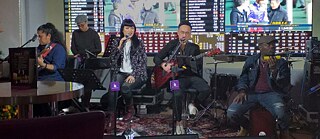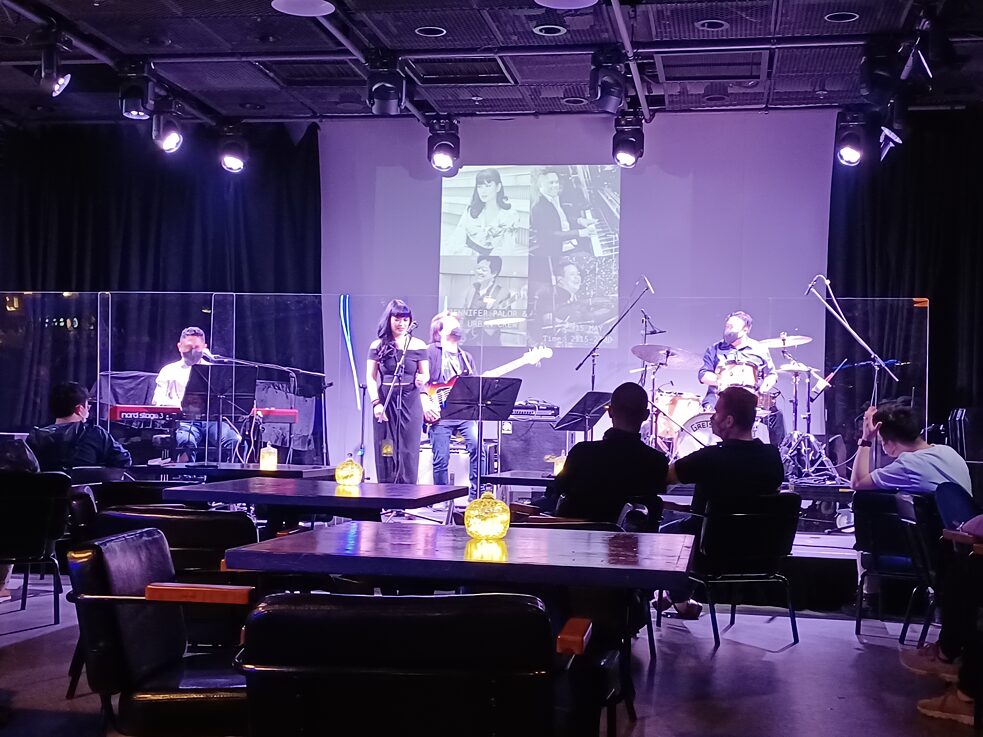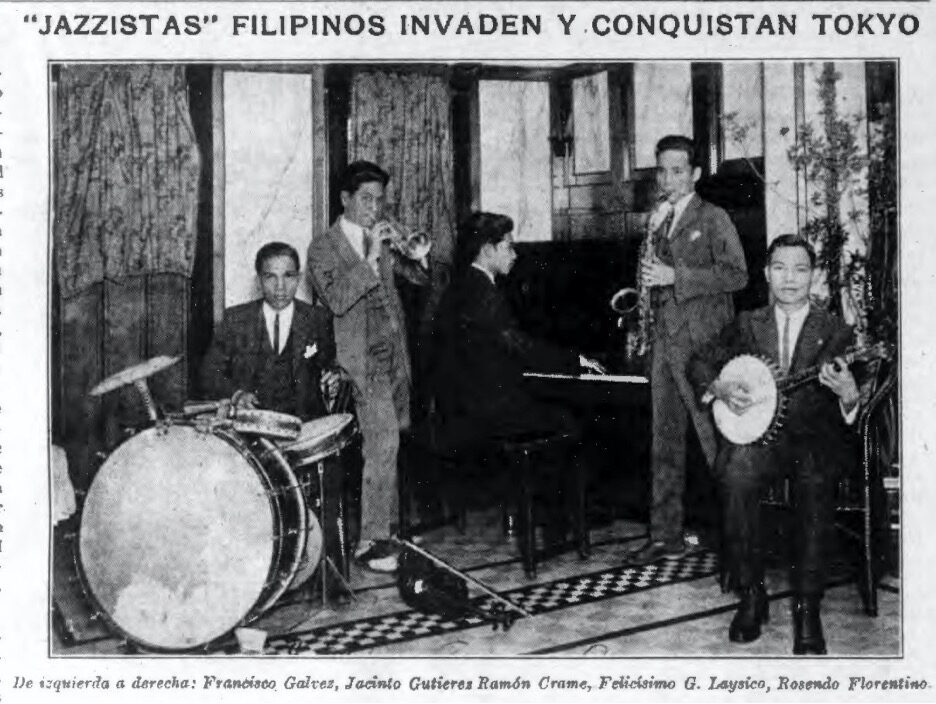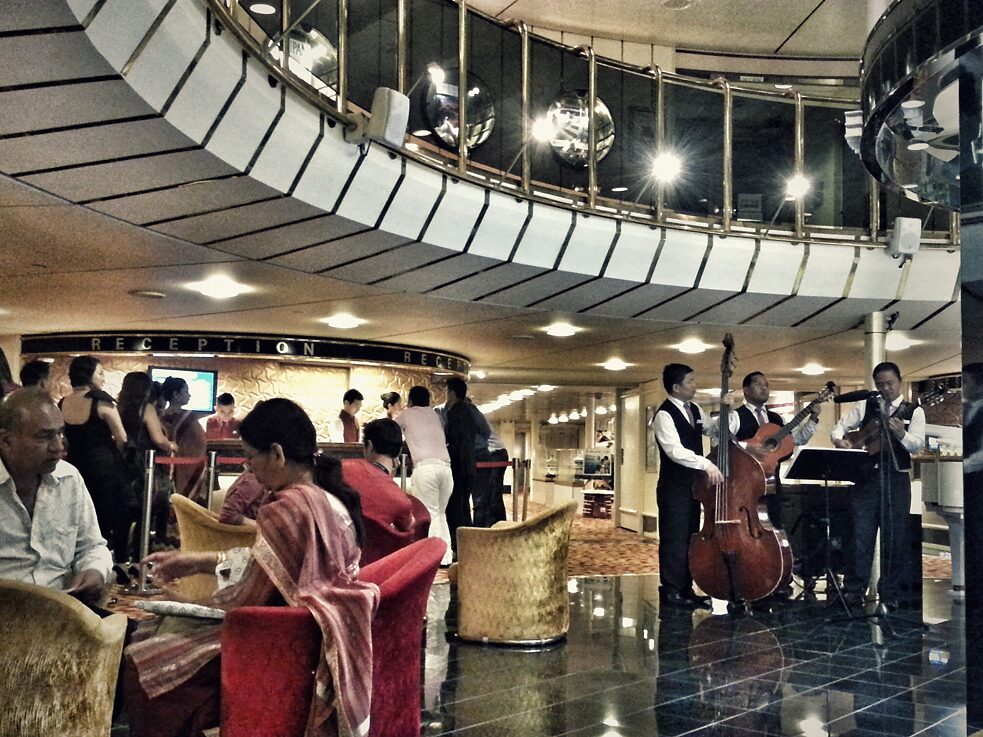
Understanding the Work of Live Music
Liveness as Livelihood
By Anjeline de Dios, 2021With worldwide bans on live music, the pandemic has cut off an essential engine of social connection and cultural vitality. In the case of overseas Filipino musicians in Asia, it has also revealed historical challenges to valuing musical liveness itself as a form of cultural and migrant labour.
Live music: Precarious and persistent
Long before Covid-19 discourses raised the existential question of which jobs are or aren’t essential, no one understood the precarious nature of music as work more than the people who made a living from it. “Entertainment is the first to go,” mused Iskandar, an agent for Filipino live music acts destined for hotel lobbies and lounges throughout Asia. An avowed music lover, he took pride in championing the exceptional talents on his roster, shepherding them through the caprices of hotel managers and the bureaucratic hurdles of leaving the Philippines as migrant workers. Some of his musicians, he told me, had been with him for over two decades. Through their remittances earned from international gigs, they had put kids through school, paid hospital bills, and built family homes in the Philippines. As Iskandar saw it, his mission as a music agent was twofold: support worthy talent in an unforgiving market, and teach clients to value that talent.Until recently, this opportunity to earn a stable livelihood through performing live music co-existed paradoxically with the broader prejudice against entertainment as a non-essential expense for audiences and venue owners alike. Today, the resumption of live music feels like a mirage, tenuous in its possibility of re-existence. Here in Hong Kong, the double-whammy of social protests in 2019 and the pandemic in 2020 put leisure and cultural establishments through a protracted period of closure. Musicians in the city have been out of work for over a year and a half. As vaccines become more widely available, performance spaces such as clubs, hotels, rehearsal studios, KTV lounges, and concert halls are tentatively reopening, following compliance with government regulations around mask-wearing, staff testing, and social distancing.
Past covid outbreaks in bars and clubs have complicated the return of live music to such venues in Hong Kong which, in terms of licensing permits, are classified as catering establishments rather than dedicated performing arts spaces (such as theatres and concert halls). The distinction has surfaced a problematic double-standard: while restrictions on concert-hall performances and restaurant dining activities were relaxed early, the ban on live music lasted for more than a year, and was only lifted after determined lobbying and appeals by musicians’ groups. This, in spite of the studies showing that the infection risk of playing wind instruments or is no different, or even less, than speaking and dining face-to-face.
There have been peculiar workarounds in the face of this persistent misperception of live musicians as superspreaders. In May, Filipina singer Jennifer Palor returned to her first gig in 15 months at a live music lounge in the government-managed West Kowloon Cultural District. In compliance with a special arrangement for the venue, Palor and her band performed only after the staff had ceased taking orders and requested everyone to take their food and drinks outside the venue. The logic was simple, if awkward: de-escalate the supposed risk of transmission by removing the food and drinks from the premises, and convert the indoor space into a performance-specific venue.
 Jennifer Palor and the Urban Crew perform at Lau Bak Freespace Livehouse in Hong Kong’s West Kowloon Cultural District, May 15, 2021. | Photo: Anjeline de Dios.
Jennifer Palor and the Urban Crew perform at Lau Bak Freespace Livehouse in Hong Kong’s West Kowloon Cultural District, May 15, 2021. | Photo: Anjeline de Dios.
The musicians powered through two sets of soul and acid jazz hits behind a clear plastic stage barrier, while masked audience members listened from bare tables or outside on a grassy knoll, drinking wine from takeout cups. We erupted into uncontrollable applause during the band’s sound check. Visibly sheepish, Palor apologised, “this is our first performance in more than a year, we’re a bit rusty.” After the gig, she spoke to me of how strange it felt to be doing something that had once come to her so naturally. “During rehearsals, we were shocked by how much we weren’t gelling together,” she said. “I felt so out of breath, and my voice felt so weak.”
As one of those listeners that night, however, I could hear nothing but the perfection of the moment: drink in hand, good friend in tow, and Palor’s polished, sensuous alto giving life to familiar songs that suffused the present with unexpected memories.
Palor’s poignant return to the stage speaks volumes of the uncertain future of Hong Kong’s live music scene, for centuries the sonic manifestation of its unabashedly capitalist and freewheeling cosmopolitan spirit. As with other cities, most musicians in the live sector work as independent contractors and are ineligible for the government financial assistance earmarked for performing artists in cultural institutions. Additionally, the majority of live music performers are non-Cantonese-speaking foreigners, with migrant Filipinos forming a sizable group.
As Iskandar noted, live musicians have weathered all manner of existential threat to their livelihood through the centuries, whether it is the caprices of venue owners and market trends, or sea changes in audio technology that render forms of liveness redundant. Live music accompaniment for silent films and radio shows was obliterated by the introduction of “talkies” and records in the mid-20th century, prompting union action by out-of-work musicians. In more recent decades, big bands were wiped out by the popularisation of turntables and MIDI sequencers. The latter was a major reason for the sudden unemployment of Filipino bands in 1970s Hong Kong, as dance floors were filled with the sounds of disco records instead of “combo” groups playing live.
And yet, just as employment conditions for live music work have remained precarious over centuries, so too has its appeal and value persisted. Clearly, audiences experience an energy in live music that can’t be replicated by cheaper and more automated forms of sounding; and performing live holds special meaning for musicians seeking not just financial remuneration, but fulfilment. This has everything to do with the special quality of “liveness” itself, embedded as it is in a particular location, performing a distinct function. But why, for all its essential worth, should it remain so precarious and misunderstood?
Singing while Filipino
Nowhere is the contradictory nature of musical liveness—its disparagement as a form of livelihood and its importance in urban cultural life—more evident than in the figure of the migrant Filipino musician. Though it’s difficult to find data on the exact population figures, strong archival evidence suggests that Filipino musicians have been serenading and entertaining audiences throughout Asia and the rest of the world since at least the 19th and early 20th centuries. An all-Filipino jazz band performs for dancers at the Imperial Hotel in Tokyo, 1924. Image courtesy of Fritz Schenker.
| Photo: Anjeline de Dios.
An all-Filipino jazz band performs for dancers at the Imperial Hotel in Tokyo, 1924. Image courtesy of Fritz Schenker.
| Photo: Anjeline de Dios.
Today’s Filipino entertainers continue a lineage of 19th- and 20th-century viajeros, or sojourner-musicians who performed a large swathe of European and American musical genres for rapidly modernising and urbanising Asia. Crossing from India to China, and weaving through Southeast Asia, they performed in ballrooms, theatres, and churches; conservatories and royal courts; cruise ships, churches, and parades. They filled out the ranks of military bands, orchestras, and multiethnic touring ensembles, and worked behind the scenes as educators, musical arrangers, and composers.
This deep history has meant that Filipino musicians are known more for a mode of musical “labour”—the live performance of popular music—in contrast with other non-Western musicians whose identities rest on aesthetic “genres” labeled as culturally authentic. They confound postcolonial aesthetes such as the British essayist Pico Iyer who, in his 1989 book Video Night in Kathmandu, wrote mournfully of Filipino bar musicians: “Almost everyone came up to deliver flawless imitations of some American hit. This development of musical mannequins struck me as strange, especially in a country that understandably regarded its musical gifts as a major source of national pride. I could certainly see how the Filipinos’ brilliance at reproducing their masters’ voices, down to the very last burr, had made them the musical stars of Asia. But as a form of self-expression, this eerie kind of ventriloquism made me sad.”
Iyer’s melancholy perpetuates problematic assumptions about “original” self-expression as the only valid aim of musical labour. It also reproduces the pressure for non-Western musicians to represent an easily romanticised authenticity. But condemning Filipino live musicians as “musical mannequins” ignores the economic, social, political, and indeed creative dynamics of being a postcolonial performer—and reduces the act of live performance to a matter of proving one’s musical worth according to a narrow (and elitist) set of artistic and cultural values.
There’s a fairer and sharper take from another global flâneur. Like Iyer, Anthony Bourdain was struck by the Filipino live musicians in seemingly every Asian city he visited, ubiquitous in presence and flexible in range. In a 2017 essay the late chef and author wrote: “In hotel bars in Chiang Mai, in lobbies in Singapore, cocktail lounges in Colombo and Kuala Lumpur and Hong Kong, wherever I go, I find a Filipino cover band able, on request, to play ›Dark Side of the Moon‹ note for note before moving on to Happy Birthday (in English, German or Cantonese), Patsy Cline, Celine Dion—and then ›Welcome to the Jungle.‹ I had to know more. Where did they all come from?”
Bourdain flew to Manila to find out, devoting an episode of his travel and food show Parts Unknown to the cuisine and urban culture of the Philippines. He found the live musicians there to be the epitome not of a soulless lack of originality, but of the country’s bigger reality of labour migration: exporting helpers, nurses, and other service workers to tend to the world’s need for care, and the country’s need for foreign remittances. Unlike Iyer, he seemed to understand that beyond the issue of whether Filipinos’ musical gifts are wasted on imitation lay the deeper questions of what these gifts actually produced, how they could be seen as part of a larger economy of migrant work. That skill, to his ears, put the musicians on par with the originating artists.
Like Bourdain, I heard in live music something that spoke volumes of what it meant to be Filipino, as a thoroughly contemporary national identity reckoning with deep histories of colonialism and globalisation in ways that were more complex than Iyer’s nostalgic exoticism. To understand the nature of making a living from musical liveness—and the reasons why Filipinos have remained the “ideal” musician-worker for the job through the centuries—I interviewed and listened to nearly 70 Filipino musicians and agents working abroad in hotels, cruise ships, bars, and theme parks in Hong Kong, Macau, Singapore, and Malaysia. I also spoke with musicians and agents in Manila and Cebu, to get a better sense of how different locations (abroad versus at home) shaped the same job (playing live) in drastic ways. Their stories show how the distinction and precarity of live music work comes down to two basic factors often misunderstood by people outside the sector: the nature of live music as service work, and the transnational profile of its workers.
Entertainment at your service
Live music is entertainment. This definition sounds unnecessarily obvious, but it is key to understanding its difference from other music genres and economies that, on the surface, seem to be about the same thing. Performing to entertain is a distinct kind of aesthetic labour that aims to create a social experience of fun and leisure. In other words, it is entertainment, live music is service work.Unlike forms of performance (mostly elite) which privilege the artist’s subjectivity, entertainment puts the audience’s experience front and centre—much in the same way that a gracious host would open their home to visitors, skillfully listening for their preferences at every moment of their stay. What kind of songs could these guests possibly like? What mood do they seem to be in? What vibe goes well with this specific moment and atmosphere, at this time of the night, week, or year?
Live performers in hotels, pubs, and parties constantly scan the room for answers to these questions, picking up cues as they perform. Crucially, they attune to listeners who may not even be there for them at first, but might be sonically persuaded to stay (and pay) because of them. “We don’t have an audience audience, but people are always listening! Whether it’s the wait staff, the manager, or the guests themselves,” said Solana*, a hotel singer in Macau.
Unlike performers who headline concerts on the strength of celebrity (like pop stars), or the value of the repertoire (such as interpreters of traditional or classical music), live musicians in leisure venues are not the main attraction. But the task of providing background music entails just as much precision as actively performing “for” listeners’ undivided attention.
 An all-Filipino guitar trio performs at the lobby of a cruise ship sailing from Penang, Malaysia to Phuket, Thailand in 2013.
| Photo: Anjeline de Dios.
An all-Filipino guitar trio performs at the lobby of a cruise ship sailing from Penang, Malaysia to Phuket, Thailand in 2013.
| Photo: Anjeline de Dios.
“Imagine you’re a businessman who goes to the bar so you can unwind after a long day at work,” said Fernan*, a hotel pianist and guitarist in Singapore. “And then when you get there, you hear wrong notes and stuff. Won’t that stress you out even more?”
Leisure venues such as hotels and clubs must not only anticipate the preferences of the widest possible range of customers, but also reliably produce the most acceptable, or least offensive, version of well-loved songs—hence the emphasis on fidelity to recorded versions rather than performers’ creative whims.
The technical challenge of reproducing popular music doesn’t contradict the onus for artistic authenticity so much as shift its terms—from cultural and aesthetic to emotional and embodied. On a visit to a hotel lounge in Penang, Malaysia, I met Drew and Monica*, a Filipino acoustic duo who enhanced the polish of their onstage performance with offstage warmth and generosity. Monica waved to me from the stage as soon as I entered the venue, and approached me in between sets to say hello and introduce herself. At one point, she raised her wineglass to propose a toast: one of their regulars had brought along his elderly mother, who was celebrating her 75th birthday. Touched by the fact that I had stayed until their last set ended at one in the morning, they invited me to join their post-performance meal. Monica laughed when I brought up her birthday toast. “Yes, I try to catch up with everyone listening. Just to give them that feeling of, ›hey the singer remembers me‹.”
Drew agreed. “It matters a lot because the connection is there. You like the band and the band likes you. It’s easier for the guests to bring their friends next time.”
The service work of live music thus involves several layers of listening, all feeding into an intangible but visceral experience of connection. There is the mimetic listening required to faithfully reproduce competent, record-quality versions of popular songs in the off-chance that they might stir a memory or tickle a fancy. Then there is the empathetic listening needed to assemble a repertoire suited to the temperament of the audience and the moment itself. There is also the engaged listening deployed in offstage chats with guests—to say nothing of the intuitive listening required to play in sync with one’s bandmates onstage, especially when improvising a song request that no one has prepared for (a common scenario). Though it seems frivolous, the affective power of live music can make or break the popularity of a venue. And it demands nothing less than the ability to make an audience feel special and welcome: turning customers into guests, making foreigners feel at home.
Seen this way, performing music live for entertainment closely resembles jobs in childcare, call centers, and tourism. Yet unlike them, musicians must manage their emotions by channelling them into the expressive and technical activity of musical performance. They need to feel the song, no matter what they feel inside.
“Your personality will show up in the way you play,” Brian*, a theme park performer, informed me. “If you’re happy, then your music sounds happy. If you feel angry, you’ll ›play‹ angry!”
A true entertainer makes hard work look like fun—so much so that they might experience the fun themselves. Though the preferences of audiences and venue owners are paramount, the musicians I interviewed all agreed that only “real” musicians who knew how to “play from the heart”—connecting the music and the interplay with fellow musicians to their individual experiences of affect and performance—could be effective entertainers.
“That’s why we call it ›playing‹ and not ›working‹ music,” said Palor. “With music, you cannot pretend. It is baring your soul each gig, trying to create magic, bouncing off energy with your fellow musicians, and (sometimes!) connecting with your listeners.”
Cheap, high-quality talent
This transparency of feeling complicates the work conditions of live music. The requirement of emotional authenticity, as well as the possibility of genuine enjoyment can obscure the entrenched job difficulties of freelancers who have little bargaining power over their salaries and working conditions. Live musicians in Hong Kong and other cities tend to be foreigners, owing perhaps to the international clientele of their workplaces, the predominance of English-language songs in the repertoire, and the short-term nature of their contracts. Pre-pandemic, they would have been able to sustain their livelihoods through flexible migration trajectories: a six-month contract in one city followed by a stint in another location. For reasons of necessity and desirability, Filipino musicians fit the ideal mould for the live music entertainer: fluent in English and dazzlingly flexible in musical range, they also “culturally” possess the emotional skills of empathy and enthusiasm so central to service and care work. In fact, these “natural” or racialised abilities of “Filipinoness” are actively shaped by market and institutional actors, from individual agents to the Philippine government itself, which functions as a massive brokerage state that exports Filipino citizens for overseas jobs.Because live music relies on a wide repertoire of Western, specifically, Anglophone pop music, the Filipino musicians I spoke to were especially sensitive to this demand for emotional, aesthetic, and functional flexibility. Non-Western artists performing in international spaces bear a representational burden to be culturally, even racially, authentic. Nothing upends this expectation more than the sight and sound of a brown-skinned Filipino effortlessly belting American hits. Iyer’s judgment that Filipino live musicians are “mannequins” somehow inferior to their white or black counterparts (regardless of their actual skill) is a common sentiment among employers in Hong Kong and other destination cities, who exploit Filipino musicians on this basis.
Painfully aware of this discrimination, and the structural uncertainty of live music work, overseas Filipino musicians often charge or acquiesce to wages lower than their counterparts of different nationalities. “In terms of demand, Filipinos are cheap,” Fernan explained to me. “Compared to South Africans, Americans, Malaysians, Hong Kongers, Thai—they all go abroad too. And Filipino musicians are the cheapest, ›but‹ better than most. Cheap and high-quality talent. That’s how Filipinos are ›branded,‹ you see. That’s all we have.”
Essential work
Therein lies the paradox of live music: it is high-skilled work in conditions of inequality and uncertainty normalized in low-wage migrant jobs. So long as employers, audiences, and economies continue to disregard and misunderstand the dignity of live music as work, it will continue to be shaped by deep structures of racial and cultural inequity.The pandemic has inflicted unprecedented damage, the extent of which is hard to calculate. In Hong Kong, hundreds of Filipino migrant musicians have been jobless over the last year and a half, and unable to fulfil their roles as their families’ primary breadwinners. As with artists’ communities elsewhere, musicians have taken care of each other, organising food drives and care networks to provide immediate assistance to less fortunate members of their community. If we are to hope for a full recovery, however, more help needs to come—and greater change needs to happen.
For centuries, we have relied on the work of live music to bring life, energy, and a sense of home to the city. As some parts of the world emerge from the pandemic’s enforced silence, it is high time that the work of liveness—as art, service, and care—be heard newly and differently. It has always been time, in other words, to understand live music as essential livelihood and life-giving labour.
* The names used in this article have been changed to protect the identities of individuals.